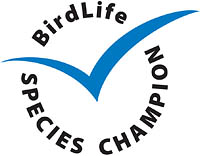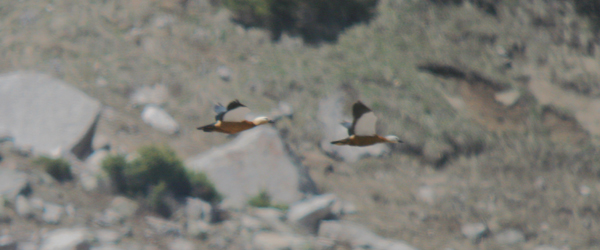Big Almaty Lake, about thirty kilometers south of the city of Almaty, is a glacial-fed lake situated at just over 2,500 meters in the Tien Shan Mountains. During the summer it reflects the three peaks that surround it but when we visited in May it was still largely frozen. The river that feeds the lake, however, was not at all frozen, and it was shallow and running over gravel, which explained why we wanted to be there so much, as high altitude rivers like that are perfect habitat for the Ibisbill, a bird that we all wanted to see very, very, very, very, much. But I am getting ahead of myself: before we started searching for the Ibisbill we all had to get out of the vans and revel in the beauty of Big Almaty Lake.
Once we got over the fact that we were in a place surrounded by absolutely breathtaking scenery we started paying attention to finding birds, like the House Martin colony in a building just off the lake. I didn’t pay much attention to the House Martins because I wanted to find mountain specialties and I figured the martins would be there when we walked back out from the trail. I did, however, pay lots of attention to my life Ruddy Shelducks that were foraging in the little bit of open water in the lake, and, later, when the flew around for awhile, I took dozens of shots of them with the mountain scenery as a back drop and the second picture below is the best I managed.
In the left of the picture above is the open water the Ruddy Shelducks were foraging in and below are the shelducks in flight.
Anyway, my time watching the shelducks foraging in the lake was somewhat shortened because I heard the excited cry of “Himalayan Snowcock!!!” and could not help but run to where I could see a line of birders with scopes trained on the ridge high above them (and I mean run, despite the binoculars, the camera, and the scope on tripod). And I had to run all the way to where those folks are standing in the lower left of the picture below.
Why would I run, risking equipment, bodily harm, and dignity? Because, as mentioned in yesterday’s post, any bird with the word “Himalayan” in its name needs to be seen and also ever since I read about the Himalayan Snowcock introductions in the United States I have wanted to see one and the chance to see one in mountains it arrived at under its own power was way too cool to ignore. So I ran, arrived, and got scope on bird. It actually looked much nicer than the pair in the heavily cropped and tweaked picture below do.
In my defense (I’m not THAT bad a digiscoper), the picture below will show you the range at which we were trying to get shots.
After seeing and watching the snowcocks for awhile, and hearing their eerie cries echo down the mountainside I moved on, spotting, with the help of the other birders on the trip, Hobby, Blue-capped Redstart, Hume’s Leaf Warbler, (Winter) Wren, Lesser Grey Shrike, Himalayan Rubythroat, Red-fronted Serin, and Black-throated Accentor. Unfortunately, of all of those species I only managed to photograph the Lesser Grey Shrike.
Collectively, we all probably spent more time scanning for what turned out to be the elusive Ibisbill than we did looking for all other species put together. The going theory is that it was just a bit too early in the year for the amazing bird but I guess missing the Ibisbill gives me an excellent reason to return!
We had more places to visit and more birds to see though, so we hiked back to the vans and moved on from Big Almaty Lake and further up into the mountains. You can come back here soon to find out what else we saw, and you can also check out Discovering Alpine Birds (where there is a nice picture of me very happy after seeing the snowcocks) or Weedon’s World of Nature to see others’ blog posts about the birds we saw in the Tien Shan Mountains.
________________________________________________________________________________________________
My trip to Kazakhstan was made possible by the wonderful folks at Swarovski Optik who sponsored the trip  not only to draw attention to their marvelous optics but to the fact that Swarovski Optik is, with the RSPB, the Species Champion for the Sociable Lapwing, a critically endangered species that breeds almost entirely in Kazakhstan. We here at 10,000 Birds, the only blog designated a Species Champion by BirdLife International, salute Swarovski Optik‘s commitment to conservation.
not only to draw attention to their marvelous optics but to the fact that Swarovski Optik is, with the RSPB, the Species Champion for the Sociable Lapwing, a critically endangered species that breeds almost entirely in Kazakhstan. We here at 10,000 Birds, the only blog designated a Species Champion by BirdLife International, salute Swarovski Optik‘s commitment to conservation.
To learn more about 10,000 Birds’ commitment to conservation through BirdLife International’s Species Champion program and what it means to us at 10,000 Birds (or to donate to the program through 10,000 Birds) just click on the nice Species Champion logo to the right.





















every time I see shots of our first Himalayan Snowcock site, I am stunned at just how far away they were and how clearly we could hear them. Congrats go to Phillipe for finding them!
gotta go, got some wallcreepers to go find (and a nest if I am really lucky 😉